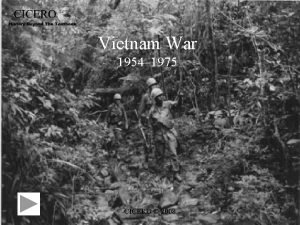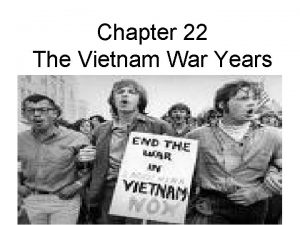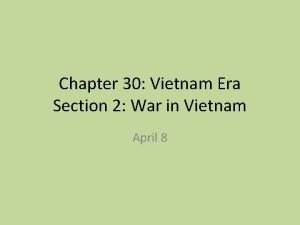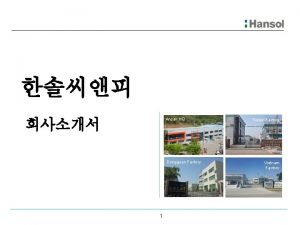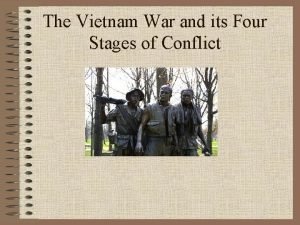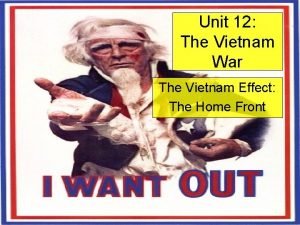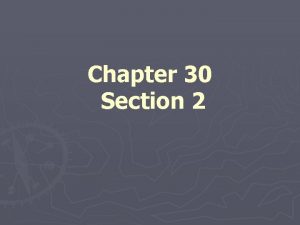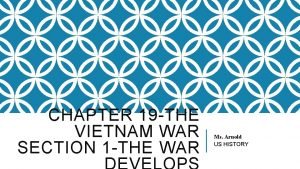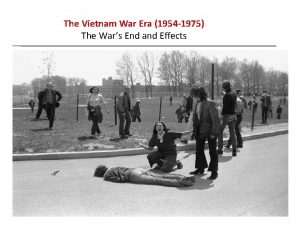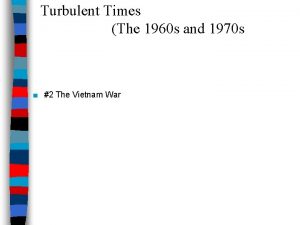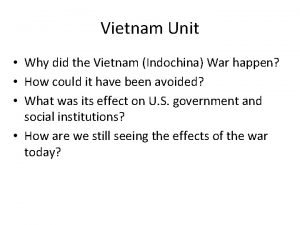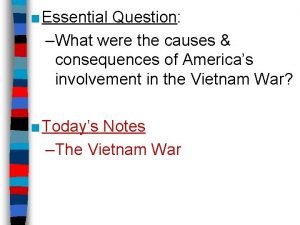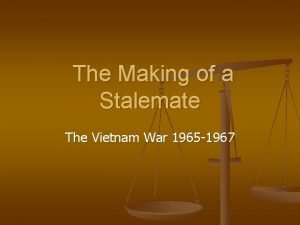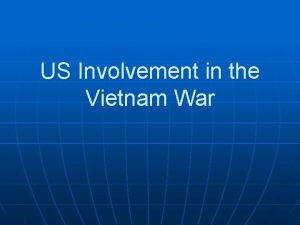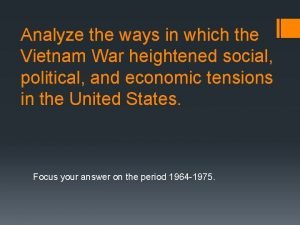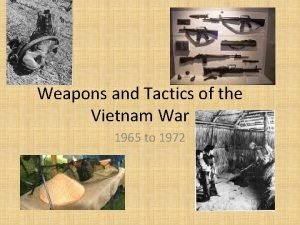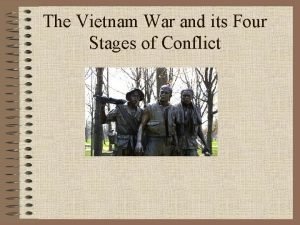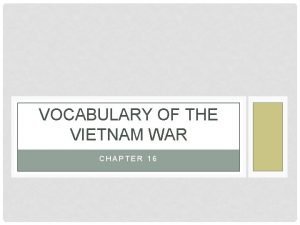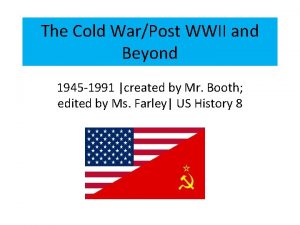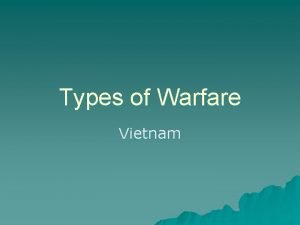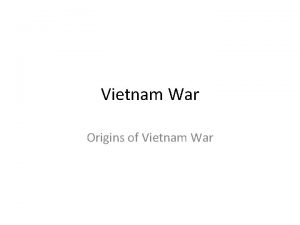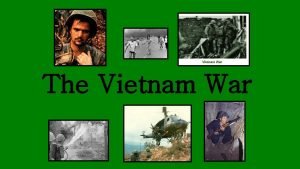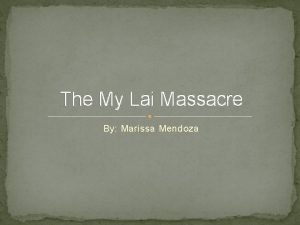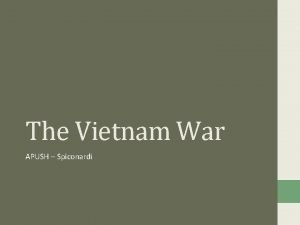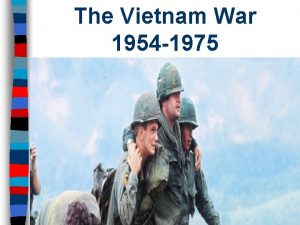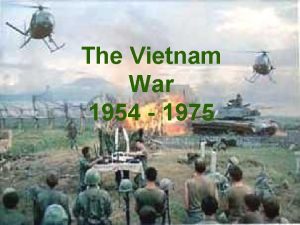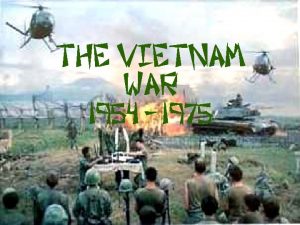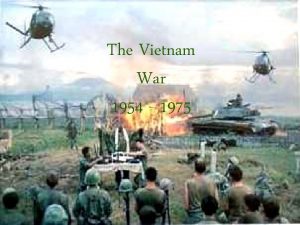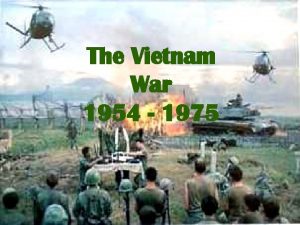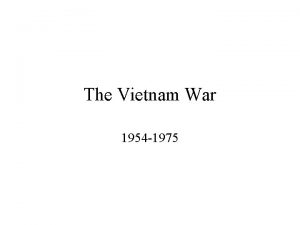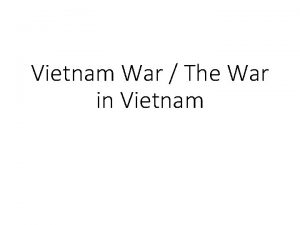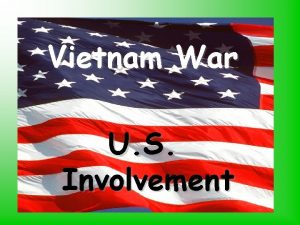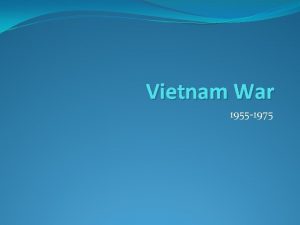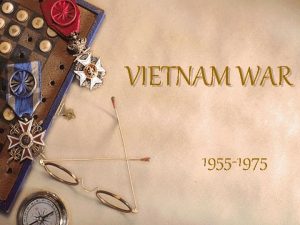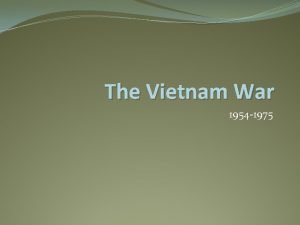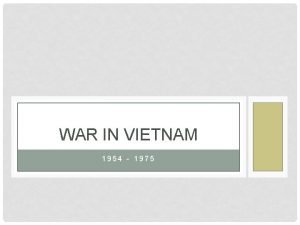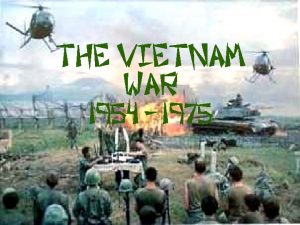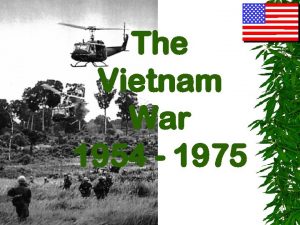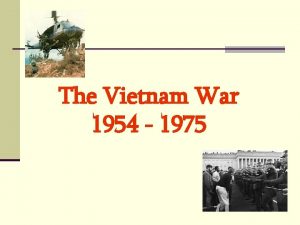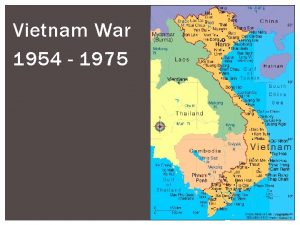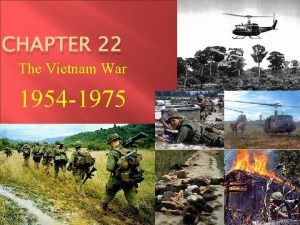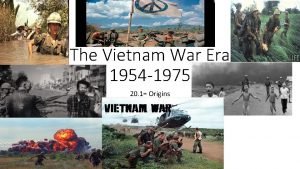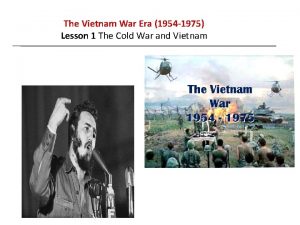THE VIETNAM WAR YEARS 1954 1975 AMERICA SUPPORTS



























- Slides: 27

THE VIETNAM WAR YEARS 1954 -1975

AMERICA SUPPORTS FRANCE French Rule in Vietnam Late 1800 s – WWII: France rules most of Indochina § Ho Chi Minh: Leader of the Vietnamese independence movement § Helps to create the Indochinese Communist Party 1940: Japanese take control of Vietnam § Vietminh: Organization that aims to rid Vietnam of foreign rulers September 1945: Ho Chi Minh declares Vietnam an independent nation

AMERICA SUPPORTS FRANCE French Battle the Vietminh French troops move into Vietnam § Fight to regain cities in the South § 1950: US begins economic aid to France in an effort to stop the spread of communism Vietminh Drive Out the French 1954: Vietminh overrun the French at Dien Bien Phu § France surrenders § The Geneva Accords divide Vietnam at the 17 th Parallel § Election to unify the country scheduled for 1956

THE US STEPS IN Diem Cancels Elections Ho Chi Minh won popular support in the North by breaking up large estates & redistributing land to the peasants South Vietnam’s anti-communist president – Ngo Dinh Diem – refuses to participate in the election § US promises military aid & training in return for a stable government in the South § Diem is corrupt, stifles opposition, & restricts Buddhism 1957: Vietcong – a Communist opposition group in the South – kills government officials § 1959: Ho Chi Minh sends arms to the Vietcong along the Ho Chi Minh Trail

THE US STEPS IN Kennedy & Vietnam Like Eisenhower, Kennedy backs Diem financially & sends military advisors Diem’s popularity plummets due to corruption & the lack of land reform § Starts a strategic hamlet program to fight the Vietcong § Continues attacks on Buddhism – monks burn themselves in protest November 1963: US supported military coup topples the government § Diem is assassinated

THE US STEPS IN

LBJ EXPANDS THE CONFLICT The South Grows More Unstable A succession of military rulers take control in the South Tonkin Gulf Resolution In response to an alleged attack on the USS Maddox, LBJ asks for increased military powers § 1964: Tonkin Gulf Resolution gives the president a “blank check” § February 1965: Operation Rolling Thunder orders sustained bombing of the North § March 1965: US combat troops enter Vietnam

LBJ INCREASES US INVOLVEMENT Troop Build Up Escalates Late 1965: General William Westmoreland – US commander in South Vietnam § Thinks the Southern Army of the Republic of Vietnam (ARVN) is ineffective § Requests increasing numbers of American troops § The majority of Americans support LBJ’s early Vietnam policies

LBJ INCREASES US INVOLVEMENT

FIGHTING IN THE JUNGLE An Elusive Enemy Vietcong use hit-&-run, ambush tactics & move among civilians § Use tunnels to help withstand airstrikes, launch attacks, & connect villages § Lace the terrain with booby traps & land mines

FIGHTING IN THE JUNGLE The Battle for “Hearts & Minds” The US wants to stop the Vietcong from winning the support of the rural population However, tactics for exposing tunnels often wound civilians & destroy villages § Napalm: A Gasoline-based bomb that sets fire to the jungle § Agent Orange: A leaf-killing, toxic chemical Search & destroy missions move civilians & destroy property § Forces villagers into the cities & refugee camps § By 1967, there are over 3 million Vietnamese refugees

THE PROTEST MOVEMENT EMERGES War Divides the Nation Combat footage on nightly TV news shows the stark picture of war § Critics talk of a credibility gap between the administration’s reports and events on the ground This uncensored access to information leads to protest marches & rallies against the war § Doves: Strongly oppose the war, believe the US should withdraw § Hawks: Favor sending greater forces to win the war

THE PROTEST MOVEMENT EMERGES

THE TET OFFENSIVE A surprise Attack 1968: Villagers go to the cities to celebrate Tet – Vietnamese new year § The Vietcong hide among the crowds & attack over 100 towns & 12 US air bases § The Tet Offensive lasts 1 month before the US & South Vietnam regain control § General Westmoreland announces that the attacks are a military defeat for the Vietcong

THE TET OFFENSIVE Public Opinion Changes After the Tet Offensive, fewer Americans support the war The mainstream media begins to openly criticize the war § Walter Cronkite says the war is unwinnable § LBJ’s popularity drops – 60% disapprove of his handling of the war

DAYS OF LOSS & RAGE Election of 1968 Senator Eugene Mc. Carthy runs for the Democratic nomination as a dove Senator Robert Kennedy enters the race after LBJ’s poor showing in New Hampshire March: LBJ announces that he will not seek reelection Violence & Protest April: Riots rock over 100 cities after Martin Luther King’s assassination June: Kennedy is fatally shot after winning the CA primary

A TURBULENT RACE Turmoil in Chicago Vice president Hubert Humphrey wins the Democratic nomination § Over 100, 000 demonstrators go to Chicago § Protestors try to march to the convention – beaten by the police – riots

A TURBULENT RACE

A TURBULENT RACE Nixon Triumphs Former vice president Richard Nixon wins the Republican nomination § Promises to restore law & order & to end the war in Vietnam Governor George Wallace runs as an independent candidate § Champions segregation & states’ rights Nixon wins the presidency

A TURBULENT RACE

NIXON & VIETNAMIZATION The Pullout Begins President Richard Nixon is disappointed in the negotiations over Vietnam § National Security Advisor Henry Kissinger works on a new plan § Vietnamization – US troops withdraw while South Vietnamese troops take over “Peace with Honor” Nixon calls for “peace with honor” to maintain US dignity § Orders the bombing of North Vietnam & Vietcong hideouts in Laos & Cambodia

TROUBLE ON THE HOME FRONT Mainstream America Silent majority: Moderate, mainstream people who support the war The My Lai Massacre News breaks that a US platoon massacred civilians in My Lai village § Lt. William Calley, Jr. is convicted & imprisoned The Invasion of Cambodia 1970: US troops invade Cambodia to clear out enemy supply centers § 1. 5 million protesting college students close down 1, 200 campuses

TROUBLE ON THE HOME FRONT Violence on Campus 1970: US National Guard kills 4 in a confrontation at Kent State University in Ohio 1970: Guardsmen kill 2 during a confrontation at Jackson State in Mississippi The Pentagon Papers Nixon invades Cambodia – Congress repeals the Tonkin Gulf Resolution Pentagon Papers reveal that the government had not been honest about its intentions regarding war § New York Times Co. v. Sullivan: Prohibits prior restraint

TROUBLE ON THE HOME FRONT

THE WAR ENDS “Peace is at Hand” 1971: 60% think the US should withdraw from Vietnam by the end of the year 1972: US attacks North Vietnam Kissinger agrees to a complete withdrawal of US troops – “Peace is at hand” The Final Push South Vietnam rejects Kissinger’s plan – talks break off & bombing resumes Congress calls for an end to war – peace is signed in January 1973 The Fall of Saigon Cease-fire breaks down – South surrenders after the North invades in 1975

THE WAR ENDS

A PAINFUL LEGACY The Legacy of Vietnam US government abolishes the military draft 1973: Congress passes the War Powers Act § President must inform Congress with 48 hours of deploying troops § Congress must approve within 90 days The war contributes to US cynicism about government & political leaders
 1975-1954
1975-1954 The domino theory vietnam war
The domino theory vietnam war Korean war vietnam war venn diagram
Korean war vietnam war venn diagram Reconstruction plans venn diagram
Reconstruction plans venn diagram Space bar
Space bar Reason for vietnam war
Reason for vietnam war Vietnam war
Vietnam war Vietnam war stages
Vietnam war stages Vietnam
Vietnam Chapter 30
Chapter 30 President nixon endorsed vietnamization because
President nixon endorsed vietnamization because Effects of the vietnam war
Effects of the vietnam war Vietnam war 1960
Vietnam war 1960 Napalm vietnam war
Napalm vietnam war What were the causes and effects of the vietnam war
What were the causes and effects of the vietnam war Did the vietnam war end in a stalemate
Did the vietnam war end in a stalemate Vietnam war
Vietnam war Analyze the ways in which the vietnam war heightened social
Analyze the ways in which the vietnam war heightened social Us weapons vietnam war
Us weapons vietnam war Stages of the vietnam war
Stages of the vietnam war Vietnam war vocabulary
Vietnam war vocabulary Civil war digging deeper webquest answers
Civil war digging deeper webquest answers Punji trap victim
Punji trap victim Vientcong
Vientcong Results of the vietnam war
Results of the vietnam war Marissa lai
Marissa lai Vietnam war apush
Vietnam war apush 300 solar years to lunar years
300 solar years to lunar years
